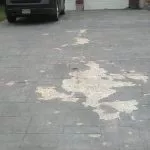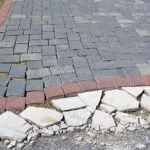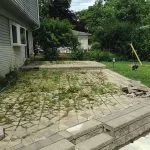Before winter arrived, you took steps to prepare your outdoor landscaping:
- You brought certain plants indoors
- You wrapped up trees and bushes in warm burlap sacks
- You spread one last layer of topsoil
- You put down fresh mulch to keep your garden warm
When it comes to your interlock pavers, you may have sealed them with Techniseal products (available at Lane’s Landscaping Supplies, by the way) in preparation for the cold weather.
But they’re still outside and exposed to the elements, whether they be snow, ice pellets, sleet, wind or just plain cold temperatures.
While you’re warm and cozy indoors, here’s what your interlock stones are dealing with.
 Corroding due to road salt
Corroding due to road salt
Driveway and sidewalk salt is a necessity to get through Canadian winter safely.
They provide much-needed traction and can help melt slippery and stubborn ice too.
Having said that, they can do quite a number on your interlocking patio stones, including:
- Stain or discolour them
- Break down the stone itself
- Get lodged in any cracks or surfaces
- Dislodge them from their base (if enough salt falls underneath them)
The main culprit behind salt damage is simply using too much of it.
Which means the easy solution is to simply use what you need and not more than that.
 Shifting
Shifting
Your patio or driveway should installed by a skilled and professional contractor.
Why?
Otherwise, the ongoing freeze/thaw cycles of winter will cause your interlocking pavers to shift in winter because:
- The aggregate base underneath isn’t perfectly flat
- When snow melts, it runs off and settles underneath the paving slabs
- The melted snow accumulates and pushes your stones up
As a result – once winter finally ends – your interlocking stones have come loose, shifted upwards and settled unevenly.
In the worst-case scenario, they may crack and need to be replaced.
Now, if your interlock products are currently buried under several feet of snow, there’s not much you can do about it except remove as much of it as possible.
But once spring hits, you can repair your stones by resettling them to ensure they’re perfectly flat and then topping up the joints between them with sand.
That second part prevents water or other debris from falling in between them in the first place.
 Excess moss growth
Excess moss growth
Even in winter, it’s still possible for moss to grow and form on your patio stones.
This is especially true if your interlock just happens to be underneath bushes or in a shady area.
The shade, combined with the moisture of snow and ice can lead to moss growing on top of your stones.
If you’re concerned about this, your best bet is to head outside (be careful not to slip) and trim any overgrown bushes or low-hanging branches.
Not only will that decrease the chance of moss growth, but it’ll also keep your backyard free and clear of debris.
Even better still is that it saves you from having to do it during your spring clean-up.
Loose flagstone
Heat makes things expand. Cold makes them contract.
When it comes to flagstone, this continual expansion and contraction cycle (it only takes a couple of degrees either way) can cause them to become loose.
In particular, two flagstone elements are susceptible:
- Facing or retaining walls
- Step installations
Not only does loose flagstone look bad, but it’s also a significant tripping and safety hazard; especially if you’ve got kids playing around your property.
Just like other interlocking pavers, your best bet against damage is to keep your flagstone free and clear of snow and ice.
And once spring hits, you may want to consider setting your flagstone with mortar.
That’s because flagstones set without mortar tend to shift more than those with it.
Come to us for all your interlock needs
Whether you’re looking for a FREE quote, need product advice or have questions, we’ve got you covered.
Just visit our contact us page, fill in the easy-to-use form and we’ll get back to you ASAP with the information you want.


 Corroding due to road salt
Corroding due to road salt Shifting
Shifting Excess moss growth
Excess moss growth